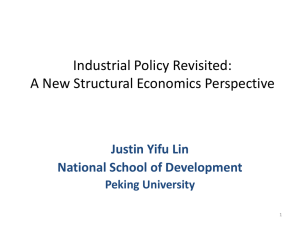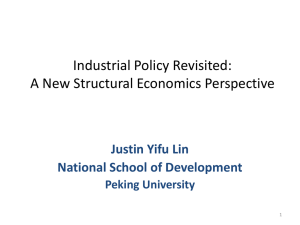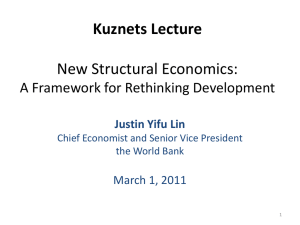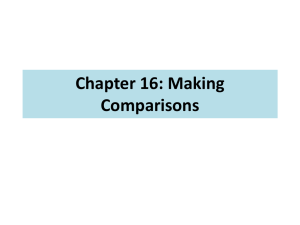Comparative advantage - International Economic Association
advertisement
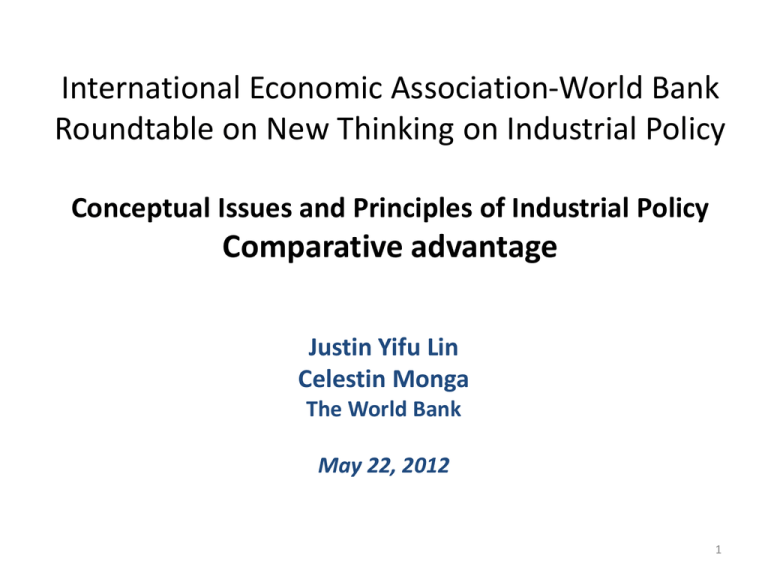
International Economic Association-World Bank Roundtable on New Thinking on Industrial Policy Conceptual Issues and Principles of Industrial Policy Comparative advantage Justin Yifu Lin Celestin Monga The World Bank May 22, 2012 1 Main Messages • A sector-targeted industrial policy is essential to achieve dynamic structural change and rapid, sustained growth in an economy. • Most industrial policies fail because they target industries that are not compatible with the country’s comparative advantage. • Successful industrial policy should target industries that are the country’s latent comparative advantages. • Historical experiences show that successful countries’ industrial policies, in general, targeted industries in countries with a similar endowment structure and somewhat higher per capita income. • The Growth Identification and Facilitation Framework, based on New Structural Economics, is a new, effective way for targeting latent comparativeadvantage industries and supporting their growth. 2 Industrial Upgrading, State Facilitation and Industrial Policy • Modern economic growth is a process of continuous technological innovation, industrial upgrading and economic diversification. • A facilitating state is essential for rapid technological innovation, industrial upgrading, and economic diversification because of the need to: – Solve coordination problems – Address externalities • Industrial policy is a useful instrument for a facilitating state. – Contents of coordination may be different, depending on industries. – The government’s resources and capacity are limited. The government needs to use them strategically. 3 Comparative Advantage Defying and the Failure of Industrial Policy • The sad fact is that almost all governments in the world attempted to use industrial policies to play the facilitating role, but most failed. • The reason is that the government’s targeted industries went against the country’s comparative advantages. – The firms in the industrial policy’s targeted sectors were non-viable in the competitive market. – To support its initial investment and to ensure the firms’ continuous operation, governments supported the non-viable firms through all kinds of subsidies and protections. – Those measures led to a lack of competition and increased rent-seeking. – As a result, the attempts to pick winners ended up picking losers. 4 Latent Comparative Advantage and Picking Winners • For an industrial policy to be successful, it should target sectors that conform to the economy’s latent comparative advantage: – Firms will be viable and the sectors will be competitive once the government helps the firms overcome coordination and externality issues. • But how can the government pick the sectors that are in line with economy’s latent comparative advantages? 5 What Can Be Learned From History? • Historical experience shows that successful countries’ industrial policies, in general, targeted industries in countries with a similar endowment structure and somewhat higher per capita income: – – – – – – – • Britain targeted the Netherlands’ industries in the 16th and 17th centuries; its per capita GDP was about 70% of the Netherlands’. Germany, France, and the USA targeted Britain’s industries in the late 19th century; their per capita incomes were about 60% to 75% of Britain’s. In Meiji restoration, Japan targeted Prussia’s industries; its per capita GDP was about 40% of Prussia’s. In the 1960s, Japan targeted the USA’s industries; its per capita GDP was about 40% of the USA’s. In the 1960s-80s, Korea, Taiwan, Hong Kong, and Singapore targeted Japan’s industries; their per capita incomes were about 30% of Japan’s. In the 1970s, Mauritius targeted Hong Kong’s textile and garment industries; its per capita income was about 50% of Hong Kong’s. In the 1980s, Ireland targeted information, electronic, chemical and pharmaceutical industries in the USA; its per capita income was about 45% of the USA’s. In the 1990s, Costa Rica targeted the memory chip packaging and testing industry; its per capita GDP was about 40% of Taiwan’s, which was the main economy in this sector. Unsuccessful industrial policies, in general, targeted industries target industries in countries where their per capita GDPs were less than 20% of the targeted countries 6 Why target industries in dynamic countries with a similar endowment structure and somewhat higher income? • Industrial upgrading is based on changes in comparative advantages due to changes in endowment structure. • Countries that have a similar endowment structure should have similar comparative advantages. • A dynamically-growing country’s industrial development should be consistent with changes in the country’s comparative advantages. Some of its industries will lose comparative advantage as the country grows and its endowment structure upgrades. Those industries will become the latent comparative advantage of the latecomers. • For countries with a similar endowment structure, the forerunners’ successful and dynamic industrial development provides a blueprint for the latecomers. 7 Growth Identification and Facilitation Step 1 Find fast growing countries with similar endowment structures and with about 100% higher per capita income. Identify dynamically growing, tradable industries that have performed well in those countries over the last 20 years. Step 2 See if some private domestic firms are already in those industries (existing or nascent). Identify constraints to quality upgrading or further firm entry. Take action to remove constraints 8 Growth Identification and Facilitation Step 3 In industries where no domestic firms are currently present, seek FDI from countries examined in step 1, or organize new firm incubation programs. Step 4 In addition to the industries identified in step 1, the government should also pay attention to spontaneous self discovery by private enterprises and give support to scale up successful private innovations in new industries. 9 Growth Identification and Facilitation Step 5 In countries with poor infrastructure and bad business environments, special economic zones or industrial parks may be used to overcome barriers to firm entry, attract FDI, and encourage industrial clusters. Step 6 The government may compensate pioneer firms identified above with: • Tax incentives for a limited period • Direct credits for investments • Access to foreign exchange 10 My ideas are presented in New Structural Economics, which can be downloaded for free from the World Bank: http://go.worldbank.org/QZK6IM4GO0 11
